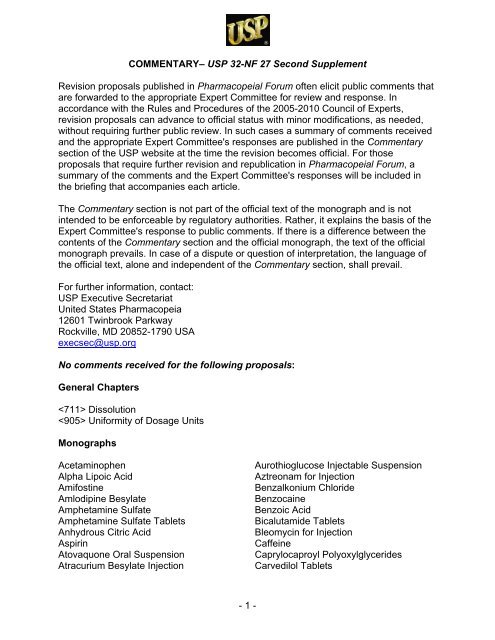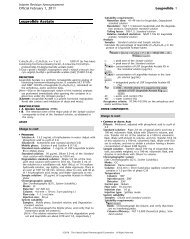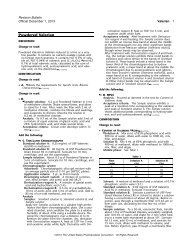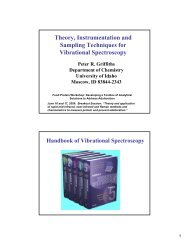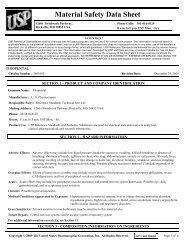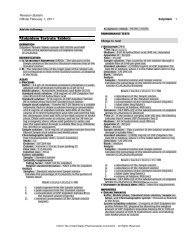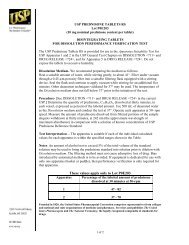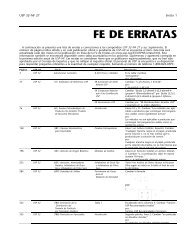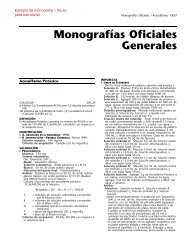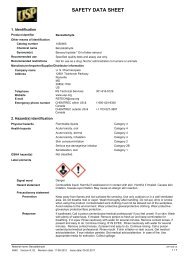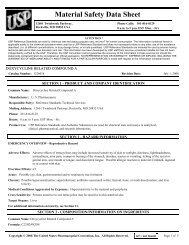COMMENTARY - US Pharmacopeial Convention
COMMENTARY - US Pharmacopeial Convention
COMMENTARY - US Pharmacopeial Convention
Create successful ePaper yourself
Turn your PDF publications into a flip-book with our unique Google optimized e-Paper software.
<strong>COMMENTARY</strong>– <strong>US</strong>P 32-NF 27 Second Supplement<br />
Revision proposals published in <strong>Pharmacopeial</strong> Forum often elicit public comments that<br />
are forwarded to the appropriate Expert Committee for review and response. In<br />
accordance with the Rules and Procedures of the 2005-2010 Council of Experts,<br />
revision proposals can advance to official status with minor modifications, as needed,<br />
without requiring further public review. In such cases a summary of comments received<br />
and the appropriate Expert Committee's responses are published in the Commentary<br />
section of the <strong>US</strong>P website at the time the revision becomes official. For those<br />
proposals that require further revision and republication in <strong>Pharmacopeial</strong> Forum, a<br />
summary of the comments and the Expert Committee's responses will be included in<br />
the briefing that accompanies each article.<br />
The Commentary section is not part of the official text of the monograph and is not<br />
intended to be enforceable by regulatory authorities. Rather, it explains the basis of the<br />
Expert Committee's response to public comments. If there is a difference between the<br />
contents of the Commentary section and the official monograph, the text of the official<br />
monograph prevails. In case of a dispute or question of interpretation, the language of<br />
the official text, alone and independent of the Commentary section, shall prevail.<br />
For further information, contact:<br />
<strong>US</strong>P Executive Secretariat<br />
United States Pharmacopeia<br />
12601 Twinbrook Parkway<br />
Rockville, MD 20852-1790 <strong>US</strong>A<br />
execsec@usp.org<br />
No comments received for the following proposals:<br />
General Chapters<br />
Dissolution<br />
Uniformity of Dosage Units<br />
Monographs<br />
Acetaminophen<br />
Alpha Lipoic Acid<br />
Amifostine<br />
Amlodipine Besylate<br />
Amphetamine Sulfate<br />
Amphetamine Sulfate Tablets<br />
Anhydrous Citric Acid<br />
Aspirin<br />
Atovaquone Oral Suspension<br />
Atracurium Besylate Injection<br />
- 1 -<br />
Aurothioglucose Injectable Suspension<br />
Aztreonam for Injection<br />
Benzalkonium Chloride<br />
Benzocaine<br />
Benzoic Acid<br />
Bicalutamide Tablets<br />
Bleomycin for Injection<br />
Caffeine<br />
Caprylocaproyl Polyoxylglycerides<br />
Carvedilol Tablets
<strong>COMMENTARY</strong>– <strong>US</strong>P 32-NF 27 Second Supplement<br />
No comments received for the following<br />
proposals, continued<br />
Ceftazidime Injection<br />
Chloral Hydrate<br />
Citric Acid Monohydrate<br />
Cocaine<br />
Cocaine Hydrochloride<br />
Codeine<br />
Codeine Sulfate<br />
Corn Oil<br />
Dantrolene Sodium Capsules<br />
Desmopressin Acetate Nasal Spray<br />
Dextroamphetamine Sulfate<br />
Dicyclomine Hydrochloride<br />
Dopamine Hydrochloride<br />
Doxazosin Mesylate<br />
Erythromycin Pledgets<br />
Ethyl Acetate<br />
Ethyl Maltol<br />
Famotidine for Oral Suspension<br />
Fexofenadine Hydrochloride Tablets<br />
Fish Oil Containing Omega-3 Acids<br />
Fluconazole Tablets<br />
Gabapentin Tablets<br />
Glimepiride Tablets<br />
Glutamic Acid<br />
Glyburide and Metformin Hydrochloride<br />
Tablets<br />
Granisetron Hydrochloride Tablets<br />
Ground Limestone<br />
Guggul<br />
Guggul Tablets<br />
Human Insulin Isophane Suspension<br />
and Human Insulin Injection<br />
Hydrogenated Polydecene<br />
Hydroxychloroquine Sulfate Tablets<br />
Ibuprofen<br />
Ibuprofen Tablets<br />
Imipramine Hydrochloride<br />
Irbesartan<br />
Ivermectin Tablets<br />
Lactic Acid<br />
Lanolin Alcohols<br />
Lauroyl Macrogolglycerides<br />
Levalbuterol Inhalation Solution<br />
- 2 -<br />
Levothyroxine Sodium Tablets<br />
Lindane<br />
Linoleoyl Macrogolglycerides<br />
Liothyronine Sodium Tablets<br />
Liotrix Tablets<br />
Lisinopril and Hydrochlorothiazide<br />
Tablets<br />
Lisinopril Tablets<br />
Methyl Alcohol<br />
Midazolam Injection<br />
Minocycline Periodontal System<br />
Moxifloxacin Hydrochloride<br />
Native Guggul Extract<br />
Niacinamide<br />
Oleoyl Macrogolglycerides<br />
Pamidronate Disodium<br />
Physostigmine<br />
Physostigmine Salicylate<br />
Physostigmine Sulfate<br />
Pilocarpine Hydrochloride<br />
Pilocarpine Nitrate<br />
Potassium Bitartrate<br />
Pralidoxime Chloride for Injection<br />
Pravastatin Sodium Tablets<br />
Purified Guggul Extract<br />
Quinapril Tablets<br />
Risedronate Sodium Tablets<br />
Secobarbital Sodium<br />
Sodium Sulfate<br />
Spectinomycin for Injectable Suspension<br />
Stearoyl Macrogolglycerides<br />
Sterile Erythromycin Ethylsuccinate<br />
Streptomycin Injection<br />
Sulfadoxine<br />
Thimerosal<br />
Thioguanine<br />
Tylosin Injection<br />
Vancomycin Hydrochloride<br />
Vancomycin Hydrochloride for Injection<br />
Vasopressin<br />
Vasopressin Injection<br />
Vinblastine Sulfate for Injection<br />
Xylose<br />
Zein
General Chapters<br />
General Chapter/Section(s): Injections/Ingredients<br />
Expert Committee(s): Excipient Monographs 2/General Chapters–Parenteral<br />
Products Industrial<br />
No. of Commenters: 3<br />
Comment Summary #1: The commenters suggested three changes to Aqueous<br />
vehicles: 1) use the Coulometric Karl Fisher titration method, which is more suitable for<br />
determination of low water contents, 2) allow the use of commercial Karl Fisher<br />
Reagents, and 3) remove chloroform due to its toxicity.<br />
Response: Comments incorporated. The Expert Committee revised the Water method<br />
from Method Ia to Method Ic (Coulometric Karl Fisher titration) and deleted a proposed<br />
solvent.<br />
Comment Summary #2: In the Limit of copper, iron, lead, and nickel test, a commenter<br />
indicated that metal catalysts are not used in unhydrogenated oils manufacturing and<br />
therefore nickel is not likely to be an impurity.<br />
Response: Comment incorporated. The Expert Committee clarified the impurities<br />
requirements by adding a Note to the Limit of copper, iron, lead and nickel test.<br />
General Chapter/Section(s): Test for 1,6-Anhydro Derivative for Enoxaparin<br />
Sodium/Multiple Sections<br />
Expert Committee(s): Biologics and Biotechnology–Blood and Blood Products<br />
No. of Commenters: 3<br />
Comment Summary #1: The commenters indicated that the equation provided to<br />
calculate the mole percent of components containing a 1,6-anhydro structure is not<br />
correct.<br />
Response: Correction incorporated.<br />
Comment Summary #2: The commenter indicated the assumption is not accurate that<br />
all species observed in the chromatogram have an equivalent response factor.<br />
Response: Comment not incorporated because the assumption is based on an<br />
equivalent molar response factor.<br />
Comment Summary #3: The commenters suggested adding a chromatogram with<br />
annotation.<br />
Response: Comment incorporated. A reference chromatogram will be provided with the<br />
instructions for use of the relevant <strong>US</strong>P Reference Standards.<br />
Comment Summary #4: The commenters suggested adding the following additional<br />
Reference Standards: 1) a control Enoxaparin Reference Standard that can be digested<br />
and chromatographed as part of system suitability, and 2) a disaccharide solution<br />
containing the ΔIS 1,6-anhydro and the ΔIS-IS 1,6-anhydro compounds.<br />
Response: Comment incorporated to include the control Enoxaparin Sodium Reference<br />
Standard (RS). The disaccharide compounds are commercially available as reagents.<br />
Comment Summary #5: The commenter suggested that the depolymerization<br />
suitability specification was not met.<br />
Response: Comment not incorporated because submitted results were obtained on the<br />
formulated drug product. The results clearly indicate an incomplete depolymerization. It<br />
- 3 -
<strong>COMMENTARY</strong>– <strong>US</strong>P 32-NF 27 Second Supplement<br />
is recommended that this test be performed on the Active Pharmaceutical Ingredient<br />
(API) rather than drug product.<br />
Comment Summary #6: The commenters indicated that the column specified in the<br />
procedure should be removed from the General Chapter because the column is no<br />
longer manufactured.<br />
Response: Comment not incorporated because the appropriate column is commercially<br />
available.<br />
Comment Summary #7: The commenters indicated that the quality of the heparinases<br />
is one of the major uncontrolled variables and therefore suggested that <strong>US</strong>P could<br />
either qualify such materials or provide them as Reference Standards.<br />
Response: Comment not incorporated because the quality of heparinases is controlled<br />
by the system suitability requirements described in the procedure.<br />
Comment Summary #8: The commenter suggested including High Performance Liquid<br />
Chromatography (HPLC) system parameters in order to ensure reproducible results<br />
between laboratories.<br />
Response: Comment not incorporated because the <strong>US</strong>P Enoxaparin Sodium<br />
Reference Standard and the associated reference chromatogram provide the<br />
appropriate controls for reproducible results between laboratories.<br />
Comment Summary #9: The commenter indicated that the concentration of acetic acid<br />
used in the method is not specified.<br />
Response: Comment incorporated to specify glacial acetic acid.<br />
Comment Summary #10: The commenter indicated that the storage conditions for<br />
material after depolymerization are not specified.<br />
Response: Comment incorporated to specify storage conditions.<br />
Comment Summary #11: The commenter indicated that the volume specified for<br />
exposure to sodium borohydride is difficult to transfer to an HPLC vial because foaming<br />
occurs upon mixing; therefore, the sample requires centrifuging before transferring to<br />
the HPLC vial.<br />
Response: Comment not incorporated because gentle mixing minimizes foaming.<br />
Comment Summary #12: The commenter suggested including requirements for<br />
expiration dates and storage conditions for mobile phases, buffers, and enzyme<br />
cocktail.<br />
Response: Comment not incorporated because expiration dates and storage conditions<br />
are manufacturing documentation and labeling requirements for regulated products.<br />
General Chapter/Section(s): Residual Solvents/Other Analytical Procedures<br />
Expert Committee(s): General Chapters<br />
No. of Commenters: 1<br />
Comment Summary #1: The commenter indicated retaining Methods I, IV, V, and VI<br />
because the Methods are used to quantitate residual solvents in approved marketed<br />
products.<br />
Response: Comment not incorporated because no supporting data was provided,<br />
indicating that these methods provide the necessary specificity and sensitivity for<br />
quantitation of the solvents listed in the current version of General Chapter <br />
Residual Solvents.<br />
- 4 -
<strong>COMMENTARY</strong>– <strong>US</strong>P 32-NF 27 Second Supplement<br />
General Chapter/Section(s): Chromatography/System Suitability<br />
Expert Committee(s): General Chapters<br />
No. of Commenters: 1<br />
Comment Summary #1: The commenter indicated that the proposed flow rate<br />
adjustments in High Performance Liquid Chromatography (HPLC) implies the flow rate<br />
can be adjusted an additional ±50% after changing to a column with a different internal<br />
diameter, regardless of the linear velocity.<br />
Response: Comment not incorporated. The proposed change was intended to allow<br />
more latitude in the adjustment of flow rate after an ID column change.<br />
General Chapter/Section(s): Total Organic Carbon/Multiple Sections<br />
Expert Committee(s): General Chapters–Pharmaceutical Waters<br />
No. of Commenters: 2<br />
Comment Summary #1: The commenter suggested removing the following sentence<br />
from the Introduction because no supporting documentation was provided: “In addition<br />
to other requirements listed below, the System suitability test is the challenge to the<br />
total organic carbon instrument.”<br />
Response: Comment incorporated.<br />
Comment Summary #2: The commenter suggested removing the proposed sentence,<br />
“For both on line and off line measurements, the appropriateness of the instrument for<br />
quality control purposes is also dependant on the sampling location(s) in the water<br />
system” (under Apparatus requirement) because the requirement is redundant and is<br />
not within the scope of the Total organic carbon procedure.<br />
Response: Comment incorporated with changes to provide clarity and guidance for<br />
both on line and off line sampling and release.<br />
Comment Summary #3: The commenter suggested revising Apparatus requirements<br />
from “sampling instrument” to instead state “water sampling.” The final revision would<br />
read as follows: “The selected sampling instrument location(s) must reflect the quality of<br />
the water used.”<br />
Response: Comment incorporated with additional changes to provide clarity and<br />
guidance for both on line and off line sampling and release.<br />
Comment Summary #4: The commenter suggested removing the proposed sentence,<br />
“The nature of the water production and use should be considered when selecting either<br />
off line or on line measurement” (under Apparatus requirement) because the nature of<br />
the water production and use is outside the scope of the chapter.<br />
Response: Comment incorporated with changes to provide clarity and guidance for<br />
both on line and off line sampling and release.<br />
Comment Summary #5: The commenter suggested replacing Other control solutions<br />
“if necessary” to read “as necessary” because the sentence is too subjective. If<br />
incorporated, the text would read: “Prepare appropriate reagent blank solutions or other<br />
specified solutions needed for establishing the apparatus baseline or for calibration<br />
adjustments following the manufacturer’s instructions, and run the appropriate blanks to<br />
zero the instrument, as necessary.”<br />
Response: Comment not incorporated because no supporting data was provided.<br />
Comment Summary #6: The commenter indicated replacing the System suitability<br />
formula to calculate Percent Recovery instead of Percent Response Efficiency because<br />
- 5 -
<strong>COMMENTARY</strong>– <strong>US</strong>P 32-NF 27 Second Supplement<br />
Percent Response Efficiency will not detect a significant calibration change for an on<br />
line total organic carbon instrument.<br />
Response: Comment not incorporated because no supporting data was provided.<br />
Comment Summary #7: The commenter suggested simplifying the System suitability<br />
mathematical form of the calculation to read as follows: “The Test solution meets the<br />
requirements if ru is not more than 0.50 mg as carbon/liter.”<br />
Response: Comment not incorporated because no supporting data was provided.<br />
Comment Summary #8: The commenter suggested including commercially available<br />
total organic carbon standards as alternatives to the <strong>US</strong>P Sucrose Reference Standard.<br />
Response: Comment not incorporated because no supporting data was provided. The<br />
Expert Committee determined that the <strong>US</strong>P Reference Standard best meets the current<br />
chapter requirements.<br />
Comment Summary #9: The commenter suggested retaining the Test solution off line<br />
and on line testing because the procedures minimize or detect artifact contamination of<br />
total organic carbon samples.<br />
Response: Comment not incorporated because no supporting data was provided. The<br />
Expert Committee further clarified off line and on line testing in Apparatus requirements.<br />
Expert Committee-initiated Change #1: The Expert Committee clarified the<br />
Introduction to read as follows: “(total carbon is the sum of organic carbon and inorganic<br />
carbon).”<br />
Expert Committee-initiated Change #2: The Expert Committee revised the<br />
Introduction from “oxidization” to read “oxidation.”<br />
General Chapter/Section(s): Osmolality and Osmolarity/ Measurement of<br />
Osmolality<br />
Expert Committee(s): General Chapters<br />
No. of Commenters: 1<br />
Comment Summary #1: The commenter indicated that permitting commerciallyavailable<br />
standard solutions allows greater flexibility while maintaining adequate<br />
calibration.<br />
Response: Comment incorporated.<br />
General Chapter/Section(s): Thermal Analysis/Multiple Sections<br />
Expert Committee(s): General Chapters<br />
No. of Commenters: 2<br />
Comment Summary #1: The commenter suggested removing the Boiling method from<br />
Table 1 because boiling is not common practice for converting liquid to gas.<br />
Response: Comment incorporated.<br />
Comment Summary #2: The commenter suggested removing the direction of the<br />
temperature change requirement because the requirement is addressed when the initial<br />
temperature, heating rate and final temperature are set into the instrument before<br />
operation.<br />
Response: Comment not incorporated because the direction of the temperature<br />
change requirement indicates either a heating rate or a cooling rate.<br />
- 6 -
<strong>COMMENTARY</strong>– <strong>US</strong>P 32-NF 27 Second Supplement<br />
Comment Summary #3: The commenter suggested clarifying and standardizing the<br />
direction of exotherms between Figure 1 Thermogram and Figure 2 Superimposed<br />
thermograms illustrating the effect of impurities on DSC melting peak shape.<br />
Response: Comment incorporated with changes. Figure 2 was revised with the<br />
endotherm down to match Figure 1.<br />
Comment Summary #4: The commenter indicated revising the Eutectic impurity<br />
analysis to provide units in the modified van’t Hoff equation and in Equation 3. The units<br />
should be: J/mol for melting range (ΔHf), J/mol × kelvins for gas constant (R) and<br />
kelvins for absolute temperature (T).<br />
Response: Comment incorporated.<br />
Comment Summary #5: The commenter indicated the Eutectic impurity analysis<br />
should additionally include the pre-existing conditions to determine which materials can<br />
use the van’t Hoff calculations to determine impurities.<br />
Response: Comment incorporated with changes for further clarification.<br />
Comment Summary #6: The commenter indicated Transition and melting point<br />
temperature should retain the paragraph beginning with the sentence: “A complete<br />
description of the conditions employed …”<br />
Response: Comment incorporated with changes. The text was reinserted under<br />
Reporting results of instrumental methods.<br />
Comment Summary #7: The commenter suggested incorporating an additional column<br />
to the Table 1 that indicates whether the event is endothermic or exothermic.<br />
Response: Comment incorporated with changes. Table 1 was revised with a new<br />
column indicating the heating cycle.<br />
Comment Summary #8: The commenter suggested standardizing the heating rates<br />
required in the Determination of transition temperature test and the Melting point<br />
temperature test.<br />
Response: Comment incorporated.<br />
Comment Summary #9: The commenter suggested standardizing the terms “peak”<br />
and “vertex” rather than using the terms interchangeably.<br />
Response: Comment not incorporated because the terms in the chapter were defined<br />
to accommodate both peak and vertex, as appropriate.<br />
General Chapter/Section(s): Assessment of Drug Product Performance–<br />
Bioavailability, Bioequivalence, and<br />
Dissolution/Multiple Sections<br />
Expert Committee(s): Biopharmaceutics<br />
No. of Commenters: 1<br />
Comment Summary #1: The commenter suggested including pharmaceutical<br />
alternatives as possible interchangeable pharmaceutical product as described in the<br />
World Health Organization (WHO) guidelines.<br />
Response: Comment not incorporated because the U.S. Food and Drug Administration<br />
(FDA) requires pharmaceutical equivalence as an element of therapeutic equivalence,<br />
in contrast to the WHO guidelines.<br />
Comment Summary #2: The commenter indicated that Bioequivalence study sample<br />
size should be based on statistical analysis and a lower limit should be defined.<br />
Response: Comment incorporated.<br />
- 7 -
<strong>COMMENTARY</strong>– <strong>US</strong>P 32-NF 27 Second Supplement<br />
Comment Summary #3: The commenter suggested in Immediate-release drug<br />
products revising a sampling truncation at 72 hours for drugs with long elimination halflife.<br />
Response: Comment incorporated.<br />
Comment Summary #4: The commenter suggested removing mention under<br />
Immediate-release drug products of a requirement for bioequivalence and bioavailability<br />
in food effect studies if the marketing label discloses that concomitant food<br />
administration does not influence the bioavailability of the drug product.<br />
Response: Comment not incorporated because a claim of no food effect implies a<br />
demonstration.<br />
Comment Summary #5: The commenter indicated Orally administered drug products,<br />
not for systemic effect should clarify when systemic monitoring may be needed.<br />
Response: Comment incorporated.<br />
Comment Summary #6: The commenter indicated under Bioequivalence studies, the<br />
subject’s data can be used in all pharmacokinetic measurements and calculations if the<br />
pre-dose drug substance concentration is less than or equal to 5 percent of the<br />
maximum drug concentration (Cmax) value.<br />
Response: Comment incorporated.<br />
Comment Summary #7: The commenter suggested expanding Bioequivalence studies<br />
to include description of food effect study conditions (e.g., high fat, high calorie meals).<br />
Response: Comment incorporated.<br />
Comment Summary #8: The commenter suggested adding a requirement in<br />
Bioequivalence studies that study subjects consume identical meals within a prespecified<br />
time.<br />
Response: Comment incorporated.<br />
Comment Summary #9: The commenter suggested revising the Statistical Analysis<br />
requirement for testing the sequence effect because the test is not current practice.<br />
Response: Comment not incorporated because no supporting data was provided.<br />
Comment Summary #10: The commenter suggested revising Statistical analysis: “In<br />
other words, data from BE studies should have a normal distribution.”<br />
Response: Comment not incorporated and the sentence was deleted.<br />
Comment Summary #11: The commenter suggested in the Two one-sided tests<br />
procedure revising the term “significant difference” to read “important difference.”<br />
Response: Comment incorporated.<br />
Comment Summary #12: The commenter suggested clarifying the comparison for area<br />
under the cureve (AUC) and maximum concentration (Cmax) by adding “of the T<br />
product.”<br />
Response: Comment incorporated.<br />
Comment Summary #13: The commenter indicated Dissolution profile comparison<br />
should calculate the similarity factor (f2) using no more than one data point that exceeds<br />
85% dissolved.<br />
Response: Comment incorporated.<br />
Comment Summary #14: The commenter suggested clarifying in Biowaver the in vitro<br />
dissolution (equivalence) test is considered more stringent and reliable than the in vivo<br />
bioequivalence test.<br />
Response: Comment was incorporated by deleting the sentence.<br />
- 8 -
<strong>COMMENTARY</strong>– <strong>US</strong>P 32-NF 27 Second Supplement<br />
Comment Summary #15: The commenter suggested that Biowaiver based on the<br />
pharmaceutical dosage form should waive in vivo comparative bioavailability or<br />
bioequivalence testing if the reference product is a solid oral immediate-release product<br />
and the test product is a solution.<br />
Response: Comment not incorporated because the sentence was deleted.<br />
Comment Summary #16: The commenter suggested Biowaiver based on dosage form<br />
proportionality should require both the lower and higher strengths in the linear<br />
pharmacokinetic range.<br />
Response: Comment incorporated.<br />
Comment Summary #17: The commenter suggested deleting in vitro dissolution study<br />
information from Biowaver based on the biopharmaceutics classification system<br />
because dissolution is not described as one of the three major factors that govern the<br />
rate and extent of drug absorption from immediate-release dosage forms.<br />
Response: Comment not incorporated because the dissolution characteristics of a<br />
dosage form needs to be evaluated when a biowaver is being considered.<br />
Expert Committee-initiated Change #1: The Expert Committee removed the<br />
“distribution” and “clearance profile” of the systemic drug exposure in Bioavailability,<br />
bioequivalence, and dissolution.<br />
Expert Committee-initiated Change #2: The Expert Committee clarified the<br />
Bioequivalence example methods for pharmacokinetic studies in humans and for other<br />
pharmacokinetic method types.<br />
Monographs<br />
Monograph/Section(s): Azithromycin for Injection/Multiple Sections<br />
Expert Committee(s): Monograph Development–Antibiotics<br />
No. of Commenters: 4<br />
Comment Summary #1: The commenter suggested revising the Bacterial endotoxins<br />
limit from “0.35 EU per mg” to “0.7 EU per mg” based on the maximum daily drug<br />
substance dose.<br />
Response: Comment incorporated.<br />
Comment Summary #2: The commenter suggested revising the pH range from<br />
“between 6.4 and 6.8, as determined in a solution reconstituted in the labeling” to read<br />
as follows: “between 6.0 and 7.0, after reconstitution in sterile water for injection to yield<br />
an approximately 50 mg per mL solution.”<br />
Response: Comment not incorporated because the current pH range reflects approved<br />
marketed product.<br />
Comment Summary #3: The commenter suggested replacing the Assay, related<br />
compounds test and the Limit of azithromycin N-oxide test with methods based on<br />
European Pharmacopoeia tests for azithromycin.<br />
Response: Comment not incorporated because no supporting data was provided. The<br />
Expert Committee is willing to consider future changes upon receipt of supporting data.<br />
Comment Summary #4: The commenter suggested revising the Related compounds<br />
test solution and the Assay preparation test solution to use 10 vials instead of 3 vials.<br />
Response: Comment incorporated.<br />
- 9 -
<strong>COMMENTARY</strong>– <strong>US</strong>P 32-NF 27 Second Supplement<br />
Comment Summary #5: The commenter suggested deleting the specifications for<br />
specifically-identified synthetic process impurities because the synthetic process<br />
impurities are controlled in the drug substance.<br />
Response: Comment incorporated.<br />
Comment Summary #6: The commenter suggested revising the acceptance criteria for<br />
the impurities in the Related compounds test to the limits specified in the drug<br />
substance monograph.<br />
Response: Comment not incorporated because the current acceptance criteria reflect<br />
approved marketed product.<br />
Comment Summary #7: The commenter suggested revising the Related compounds<br />
limit for Desosaminylazithromycin from “0.3%” to “0.7%.”<br />
Response: Comment not incorporated because the current test limit reflects the<br />
acceptance criteria for the approved marketed product.<br />
Comment Summary #8: The commenter suggested revising the limit for Ndemethylazithromycin<br />
in the Related compounds test from “0.7%” to “1.0%.”<br />
Response: Comment incorporated.<br />
Comment Summary #9: The commenter suggested revising the limit for Total<br />
impurities in the Related compounds test from “3.0%” to “4.0%.”<br />
Response: Comment not incorporated because current limit reflects the acceptance<br />
criteria for the approved marketed product.<br />
Comment Summary #10: The commenter suggested adding the chemical name for<br />
Azaerythromycin A as a footnote to Related compounds test, Table 1.<br />
Response: Comment incorporated.<br />
Comment Summary #11: The commenter suggested replacing the Limit of<br />
azithromycin N-oxide and Related compounds tests with a different validated test for<br />
Related compounds.<br />
Response: Comment not incorporated because no supporting data was provided. The<br />
Expert Committee is willing to consider future changes upon receipt of supporting data.<br />
Expert Committee initiated change #1: The Expert Committee updated the Related<br />
compounds test and Assay chromatographic column type to L67, which is the new<br />
number assigned to the column.<br />
Expert Committee initiated change #2: The Expert Committee revised the limit for N-<br />
Demethylazithromycin in the Related compounds test from “0.7%” to “1.0%.”<br />
Monograph/Section(s): Azithromycin Tablets/Multiple Sections<br />
Expert Committee(s): Monograph Development–Antibiotics<br />
No. of Commenters: 2<br />
Comment Summary #1: The commenter suggested including a pH adjustment for<br />
Solution A in the Related compounds test.<br />
Response: Comment not incorporated because no supporting data was provided.<br />
The Expert Committee is willing to consider future changes upon receipt of<br />
supporting data.<br />
Comment Summary #2: The commenter suggested revising the relative response<br />
factors in the Related compounds test since they differ from those provided in the<br />
drug substance monograph that was published in <strong>Pharmacopeial</strong> Forum 34(3)<br />
[May-June 2008].<br />
- 10 -
<strong>COMMENTARY</strong>– <strong>US</strong>P 32-NF 27 Second Supplement<br />
Response: Comment not incorporated. The relative response factors are different<br />
between the drug substance monograph and the drug product monograph because the<br />
methods are different between the two monographs.<br />
Comment Summary #3: The commenter suggested adding a Reference Standard<br />
containing a mixture of related compounds for peak identification to the Related<br />
compounds test.<br />
Response: Comment not incorporated because no supporting data was provided. The<br />
Expert Committee is willing to consider future changes upon receipt of supporting data.<br />
Comment Summary #4: The commenter indicated providing a relative response factor<br />
for 3'-N-{[4-(Acetylamino)phenyl]sulfonyl}-3'-demethylazithromycin to prevent the<br />
overestimation of this impurity in the Related compounds test.<br />
Response: Comment not incorporated because the current requirements reflect the<br />
approved marketed product.<br />
Comment Summary #5: The commenter suggested providing a combined specification<br />
for 14-demethyl-14-(hydroxymethyl) azithromycin and desosaminylazithromycin in the<br />
Related compounds test.<br />
Response: Comment not incorporated the current Related compounds test reflect the<br />
approved marketed product.<br />
Comment Summary #6: The commenter suggested revising the acceptance criteria in<br />
the Related compounds test to harmonize this monograph with the limits stated in the<br />
European Pharmacopoeia monograph for this drug.<br />
Response: Comment not incorporated because the current limits reflect the acceptance<br />
criteria in the approved marketed product.<br />
Comment Summary #7: The commenter submitted an ‘Intent to Comment’ letter.<br />
Response: Comment not incorporated because no supporting data was provided. The<br />
Expert Committee is willing to consider future changes upon receipt of supporting data.<br />
Monograph/Section(s): Behenoyl Polyoxylglycerides/Water<br />
Expert Committee(s): Excipient Monographs 2<br />
No. of Commenters: 1<br />
Comment Summary #1: The commenter indicated the Water should be increased from<br />
“0.5%” to “1.0%” for all the polyoxylglyceride monographs because polyoxyglycerides<br />
are highly hydroscopic.<br />
Response: Comment incorporated.<br />
Monograph/Section(s): Citalopram Hydrobromide/Related Compounds Test 2<br />
Expert Committee(s): Monograph Development–Psychiatrics and Psychoactives<br />
No. of Commenters: 2<br />
Comment Summary #1: The commenter suggested including a Note to indicate the<br />
location of the bromide peak and the clear instructions to disregard this peak.<br />
Response: Comment incorporated.<br />
Comment Summary #2: The commenter suggested three revisions: 1) increase the<br />
limit of Citalopram Related Compounds A, C, D, G, and H from “0.10%” each to “0.15%”<br />
each, 2) revise the limit of any individual unspecified impurity from “0.10%” to “0.1%,”<br />
and 3) increase the limit for total specified and unspecified impurities from “0.50%” to<br />
“0.75%.”<br />
- 11 -
<strong>COMMENTARY</strong>– <strong>US</strong>P 32-NF 27 Second Supplement<br />
Response: Comment incorporated.<br />
Monograph/Section(s): Cloprostenol Injection/Multiple Sections<br />
Expert Committee(s): Veterinary Drugs<br />
No. of Commenters: 1<br />
Comment Summary #1: The commenter indicated that under Related compounds test,<br />
the proposed limit of “NMT 0.1% of any individual impurity” is too restrictive and does<br />
not reflect the quality of the product available on the market. The commenter requested<br />
increasing the limit of any individual impurity to “NMT 1.0%.”<br />
Response: Comment incorporated.<br />
Comment Summary #2: The commenter requested adding a Standard solution<br />
containing 0.1mg/mL of cloprostenol sodium to the Related compounds test, and to<br />
rename the solution containing cloprostenol sodium and hydrocortisone acetate as<br />
“system suitability solution,” to be used for both the Related compounds and Assay tests.<br />
Response: Comment incorporated.<br />
Summary #3: The commenter requested a correction to the calculations under Related<br />
compounds test, to take the concentrations of the Standard solution and Test solution<br />
into account.<br />
Response: Comment incorporated.<br />
Summary #4: The commenter requested a correction to the calculation under Assay, to<br />
take into account different molecular weights of the cloprostenol and its sodium salt.<br />
Response: Comment incorporated.<br />
Monograph/Section(s): Cloprostenol Sodium/Multiple Sections<br />
Expert Committee(s): Veterinary Drugs<br />
No. of Commenters: 4<br />
Comment Summary #1: The commenters indicated that under Chromatographic purity<br />
test, the proposed limit of “not more than 0.1% of any individual impurity” is too<br />
restrictive and does not reflect the quality of the material available on the market. The<br />
commenters requested increasing the limit of any individual impurity to “not more than<br />
1.0%,” and also requested adding a note to disregard any peak below 0.05%.<br />
Response: Comment incorporated.<br />
Comment Summary #2: The commenter suggested to correct the packaging included<br />
in the Packaging and storage section to indicate that the material needs to be stored in<br />
tight and light-resistant containers.<br />
Response: Comment incorporated.<br />
Monograph/Section(s): Cottonseed Oil/Multiple Sections<br />
Expert Committee(s): Excipient Monographs 2<br />
No. of Commenters: 4<br />
Comment Summary #1: The commenters indicated revising Fatty Acid Composition<br />
specification ranges for the following: myristic acid (C14:0), palmitic acid (C16:0), oleic<br />
acid (C18:1), linolenic acid (C18:3), arachidic acid (C20:0), erucic acid (C22:1), and<br />
lignoceric acid (C24:0).<br />
Response: Comment incorporated.<br />
- 12 -
<strong>COMMENTARY</strong>– <strong>US</strong>P 32-NF 27 Second Supplement<br />
Expert Committee-initiated Change #1: The Expert Committee made two changes to<br />
the Water method: 1) revise “Method Ia” to “Method Ic” (Coulometric Karl Fisher<br />
titration), and 2) delete a proposed solvent.<br />
Expert Committee-initiated Change #2: The Expert Committee clarified Other<br />
requirements to now read “injectable dosage forms,” which are specified in Labeling.<br />
Monograph/Section(s): Ecamsule Solution/Multiple Sections<br />
Expert Committee(s): Monograph Development–Ophthamology, Oncology and<br />
Dermatology<br />
No. of Commenters: 2<br />
Comment Summary #1: The commenter suggested changing Identification test B<br />
“maxima” to “maximum” because the multiple maxima in a range of 4 nm for ultraviolet<br />
bands are not likely.<br />
Response: Comment incorporated.<br />
Comment Summary #2: The commenter suggested changing the concentration of<br />
silver nitrate from “0.1 N” to “0.01 N” for the Limit of chloride test in order to be<br />
consistent with General Chapter Titrimetry.<br />
Response: Comment incorporated.<br />
Expert Committee-initiated Change #1: The Expert Committee revised Related<br />
compounds, Table 1 relative retention times to use average values.<br />
Monograph/Section(s): Enrofloxacin/Related Compounds Test 1<br />
Expert Committee(s): Veterinary Drugs<br />
No. of Commenters: 1<br />
Comment Summary #1: The commenter suggested correcting the mixing order under<br />
the Developing solvent mixture. The commenter observed that when the components of<br />
the Developing solvent mixture were mixed in the order listed in <strong>Pharmacopeial</strong> Forum<br />
34(4) [July-Aug. 2008], the mixture did not form two layers. However, if the mixing order<br />
was “butyl acetate, n-butanol, water, and glacial acetic acid,” two distinct layers were<br />
observed.<br />
Response: Comment incorporated and a Note was added to emphasize that the mixing<br />
order should be carefully followed.<br />
Monograph/Section(s): Fexofenadine Hydrochloride and Pseudoephedrine<br />
Hydrochloride Extended/Multiple Sections<br />
Expert Committee(s): Monograph Development–Pulmonary and Steroids<br />
Expert Committee-initiated Change #1: The Expert Committee made two changes to<br />
the Assay stock preparation: 1) add a Note to consider centrifuging the stock solution if<br />
the excipients cannot be filtered, and 2) indicate the specific supernatant.<br />
Monograph/Section(s): Fludarabine Phosphate for Injection/Related Compounds<br />
Expert Committee(s): Monograph Development–Ophthamology, Oncology and<br />
Dermatology<br />
Expert Committee-initiated Change: The Expert Committee corrected Test B (Late-<br />
eluting impurities) injection volume from “10 mL” to “10 µL.”<br />
- 13 -
<strong>COMMENTARY</strong>– <strong>US</strong>P 32-NF 27 Second Supplement<br />
Monograph/Section(s): Granisetron Hydrochloride Injection/Multiple Sections<br />
Expert Committee(s): Monograph Development–Gastrointestinal, Renal and<br />
Endocrine<br />
No. of Commenters: 1<br />
Comment Summary #1: At the time of the comment (August 2008), <strong>US</strong>P Granisetron<br />
Related compound C RS was not available, and the Commenter suggested generating<br />
this impurity in the solution by exposure to sunlight or ultraviolet radiation.<br />
Response: Comment not incorporated. The <strong>US</strong>P Reference Standards for all<br />
granisetron related compounds are now available.<br />
Comment Summary #2: The commenter requested to revise the concentration of the<br />
Standard and Assay preparations under Assay from “(1.1 x L)” to “(0.11 x L)” to achieve<br />
a better peak shape. The same change is also proposed for the Standard solution under<br />
Related compounds.<br />
Response: Comment incorporated.<br />
Committee-initiated Change #1: The Expert Committee noticed that the monographs<br />
for Granisetron Hydrochloride Injection and Granisetron Hydrochloride Tablets utilize<br />
similar chromatographic systems but the requirement for column efficiency is more<br />
stringent in the proposed Granisetron Hydrochloride Injection Monograph. Based on<br />
this, the Expert Committee agreed to delete the requirement for column efficiency under<br />
the Assay.<br />
Monograph/Section(s): Itraconazole/Related Compounds<br />
Expert Committee(s): Monograph Development–Antivirals and Antimicrobials<br />
No. of Commenters: 1<br />
Comment Summary #1: The commenter indicated impurities should be identified as<br />
either “specified” or “unspecified.”<br />
Response: Comment incorporated.<br />
Comment Summary #2: The commenter suggested adding the specified impurities<br />
with their corresponding limit of 0.5% each: 4-methoxy derivative, 4-triazolyl isomer,<br />
propyl analog, isopropyl analog, epimer, n-butyl isomer and didioxolanyl analog.<br />
Response: Comment incorporated.<br />
Monograph/Section(s): Losartan Potassium Tablets/Multiple Sections<br />
Expert Committee(s): Monograph Development–Cardiovascular<br />
No. of Commenters: 2<br />
Comment Summary #1: The commenter suggested deleting the Uniformity of dosage<br />
units test procedure.<br />
Response: Comment not incorporated because the current Uniformity of dosage units<br />
procedure reflects approved marketed product. General Chapter Uniformity of<br />
Dosage Units defaults to the Assay procedure.<br />
Comment Summary #2: The commenter suggested neutralizing the pH of Stock<br />
system suitability solution using 0.1 N hydrochloride or 0.1 N sodium hydroxide.<br />
Response: Comment incorporated.<br />
Comment Summary #3: The commenter indicated adding acetonitrile to the Stock<br />
system suitability solution after the neutralization step should improve the solubility of<br />
losartan potassium. The current procedure results in a cloudy solution.<br />
- 14 -
<strong>COMMENTARY</strong>– <strong>US</strong>P 32-NF 27 Second Supplement<br />
Response: Comment not incorporated because the stock system suitability solution will<br />
become clear during the system suitability solution preparation. The Expert Committee<br />
added a Note to the Stock system suitability solution explaining the solution may be<br />
cloudy during preparation.<br />
Comment Summary #4: The commenter suggested revising the System suitability<br />
preparation from “Add 7 mL of Stock system suitability preparation to 3 mL of<br />
acetonitrile” to read as follows: “Add 3 mL of acetonitrile to 7 mL of Stock system<br />
suitability preparation to clear the cloudy solution.”<br />
Response: Comment incorporated.<br />
Monograph/Section(s): Mesna/Mulitple Sections<br />
Expert Committee(s): Monograph Development–Cough, Cold and Analgesics<br />
No. of Commenters: 0<br />
Expert Committee-initiated Change #1: The Expert Committee deleted the Limit of<br />
sulfate and Related compounds sections. The sections will be replaced after the<br />
Standard solution is revised and the Related compounds test corrects for response<br />
factors for the three respective impurities.<br />
Monograph/Section(s): Midazolam/Chromatographic Purity<br />
Expert Committee(s): Monograph Development–Pulmonary and Steroids<br />
No. of Commenters: 1<br />
Comment Summary #1: The commenter requested changing the relative response<br />
factor for desfluoromidazolam from “0.5” to “1.0.”<br />
Response: Comment incorporated.<br />
Comment Summary #2: The commenter suggested replacing the L60 column with an<br />
L1 column.<br />
Response: Comment not incorporated because no supporting data was provided. The<br />
Expert Committee is willing to consider future changes upon receipt of supporting data.<br />
Expert Committee-initiated Change #1: The Expert Committee made two changes:<br />
1) corrected the Table 1 chemical name of the 6H-isomer impurity and 2) corrected the<br />
chemical names of Midazolam and other impurities.<br />
Monograph/Section(s): Mirtazapine/Related Compounds<br />
Expert Committee(s): Monograph Development–Psychiatrics and Psychoactives<br />
No. of Commenters: 1<br />
Comment Summary#1: The commenter suggested the use of relative response factor<br />
instead of relative retention time in the calculation.<br />
Response: Comment incorporated.<br />
Monograph/ Section(s): Moxifloxacin Ophthalmic Solution/Related Compounds<br />
Expert Committee (s): Monograph Development–Antivirals and Antimicrobials<br />
No. of Commenters: 1<br />
Comment Summary #1: The commenter suggested revising the relative response<br />
factor for decarboxy compound from “0.1” to “0.13” to ensure the required two decimal<br />
places in the Moxifloxacin Ophthalmic Solution Monograph are consistent with other<br />
- 15 -
<strong>COMMENTARY</strong>– <strong>US</strong>P 32-NF 27 Second Supplement<br />
<strong>US</strong>P Monographs with relative response factor requirements, which indicate two<br />
decimal places if the value is less than 1.0.<br />
Response: Comment incorporated.<br />
Monograph/Section(s): Mupirocin Nasal Ointment/Related compounds test<br />
Expert Committee(s): Monograph Development–Antibiotics<br />
No. of Commenters: 1<br />
Comment Summary #1: The commenter indicated that the related compounds<br />
chemical names listed in the footnotes should be revised to match Related compounds,<br />
Table 1.<br />
Response: Comment incorporated.<br />
Monograph/Section(s): Norethindrone Acetate/Chromatographic Purity<br />
Expert Committee(s): Monograph Development–Pulmonary and Steroids<br />
No. of Commenters: 0<br />
Expert Committee-initiated Change #1: The Expert Committee clarified the Test 1<br />
requirement for the total impurities in thin-layer chromatography (TLC). The requirement<br />
was changed from “The sum of the intensities of all of the secondary spots is not more<br />
intense than the spot in the chromatogram obtained from Standard solution A: not more<br />
than 1.5% of total impurities is found” to read as follows: “Any individual secondary spot<br />
is not more intense than the spot in the chromatogram obtained from Standard solution<br />
B: not more than 0.5% of any individual impurity is found, and the total of impurities<br />
found is not more than 1.5%.”<br />
Monograph/Section(s): Octisalate/Assay<br />
Expert Committee(s): Monograph Development–Ophthamology, Oncology and<br />
Dermatology<br />
No. of Commenters: 1<br />
Comment Summary #1: The commenter indicated the column phase designation in<br />
the Chromatographic Reagent Database should be changed from “G2” to “G1” to be<br />
consistent with the Monograph.<br />
Response: Comment incorporated.<br />
Monograph/Section(s): Ondansetron Tablets/Definition<br />
Expert Committee(s): Monograph Development–Psychiatrics and Psychoactives<br />
No. of Commenters: 1<br />
Comment Summary #1: The commenter suggested revising the Definition to clarify<br />
hydrochloride salt is the active ingredient.<br />
Response: Comment incorporated.<br />
- 16 -
<strong>COMMENTARY</strong>– <strong>US</strong>P 32-NF 27 Second Supplement<br />
Monograph/Section(s): Oxaliplatin/Multiple Sections<br />
Expert Committee(s): Monograph Development–Ophthamology, Oncology and<br />
Dermatology<br />
No. of Commenters: 3<br />
Comment Summary #1: The commenter suggested changing the Limits of Oxalic acid,<br />
(SP-4-2)-Diaqua[(1R,2R)-cyclohexane-1,2-diamine-N,N']platinum, Oxaliplatin related<br />
compound C, Oxaliplatin related compound D and unspecified impurity.<br />
Response: Comment not incorporated because the limits in the monograph reflect the<br />
approved specifications for the marketed approved product.<br />
Monograph/Section(s): Palm Oil/Multiple Sections<br />
Expert Committee(s): Excipient Monographs 2<br />
Expert Committee-initiated Change #1: The Expert Committee revised the<br />
Introduction by adding “and” between Test A and Test B to clarify that both tests are<br />
required to identify this oil.<br />
Expert Committee-initiated Change #2: The Expert Committee made two changes to<br />
the Water method: 1) revise “Method Ia” to “Method Ic” (Coulometric Karl Fisher<br />
titration), and 2) delete a proposed solvent system.<br />
Expert Committee-initiated Change #3: The Expert Committee deleted the<br />
requirement for “freshly distilled” acetone because acetone is commercially available in<br />
suitable grades.<br />
Monograph/Section(s): Piperacillin and Tazobactam for Injection/Multiple Sections<br />
Expert Committee(s): Monograph Development–Antibiotics<br />
No. of Commenters: 2<br />
Comment Summary #1: The commenter suggested revising the pH range from “5.5 to<br />
6.8 (200 mg/mL solution)” to the range of “5.0 – 7.0 (40 mg/mL solution)” originally<br />
proposed in <strong>Pharmacopeial</strong> Forum 31(2) [Mar.-Apr. 2005].<br />
Response: Comment not incorporated because the current pH range reflects the<br />
approved marketed product.<br />
Comment Summary #2: The commenter suggested implementing the Particulate<br />
matter procedures that were proposed in <strong>Pharmacopeial</strong> Forum 31(2) [Mar.-Apr.<br />
2005] instead of the procedures that were proposed in <strong>Pharmacopeial</strong> Forum 34(4)<br />
[July-Aug. 2008].<br />
Response: Comment not incorporated because the current particulate matter<br />
acceptance criteria reflect the approved marketed product.<br />
Comment Summary #3: The commenters suggested different validated procedures for<br />
the Related compounds method.<br />
Response: Comments not incorporated because no supporting data was provided. The<br />
Expert Committee is willing to consider future changes upon receipt of supporting data.<br />
Comment Summary #4: The commenter suggested revising the acceptance criteria for<br />
the Related compounds test to match the International Conference Harmonization (ICH)<br />
guidelines and also based on data from production-scale batches.<br />
Response: Comment not incorporated because the current Related compounds<br />
acceptance criteria reflect approved marketed product.<br />
- 17 -
<strong>COMMENTARY</strong>– <strong>US</strong>P 32-NF 27 Second Supplement<br />
Comment Summary #5: The commenter suggested implementing the Assay method<br />
proposed in <strong>Pharmacopeial</strong> Forum 31(2) [Mar.-Apr. 2005] instead of the Assay method<br />
that was proposed in <strong>Pharmacopeial</strong> Forum 34(4) [July-Aug. 2008].<br />
Response: Comment not incorporated because no supporting data was provided. The<br />
Expert Committee is willing to consider future changes upon receipt of supporting data.<br />
Monograph/Section(s): Risedronate Sodium/Multiple Sections.<br />
Expert Committee(s): Monograph Development–Gastrointestinal, Renal and<br />
Endocrine<br />
No. of Commenters: 4<br />
Comment Summary #1: The commenter suggested updating the Chemical Abstracts<br />
Service (CAS) number for the hemi-pentahydrate form.<br />
Response: Comment incorporated.<br />
Comment Summary #2: Commenter suggested tightening the Heavy metals limit.<br />
Response: Comment not incorporated. The limit included in the Monograph (NMT 20<br />
ppm) is consistent with the specifications currently approved by the U.S. Food and Drug<br />
Administration.<br />
Comment Summary #3: The commenters suggested using Volumetric Karl Fisher<br />
titration rather than Coulometric Karl Fisher titration when testing for drug substances<br />
which that contain 11.9-13.9% of water.<br />
Response: Comment not incorporated. The Expert Committee noted that<br />
bisphosphonates are potent drugs, and the use of the Coulometric Karl Fisher titration<br />
allows a reduction in the sample size, thereby minimizing exposure to these drugs.<br />
Monograph/Section(s): Silicified Microcrystalline Cellulose/Particle Size Distribution<br />
Expert Committee(s): Excipient Monographs 2<br />
No. of Commenters: 1<br />
Comment Summary #1: The commenter suggested a Note that would indicate when<br />
tests would need performed for functional or product performance purposes.<br />
Response: Comment not incorporated because the test only needs performed if<br />
indicated in the Certificate of Analysis, which is consistent with the Labeling<br />
requirement.<br />
Monograph/Section(s): Soybean Oil/Multiple Sections<br />
Expert Committee(s): Excipient Monographs 2<br />
No. of Commenters: 4<br />
Comment Summary #1: The commenters indicated revising Fatty Acid Composition<br />
specification ranges for the following: stearic acid (C18:0), oleic acid (C18:1), behenic<br />
acid (C22:0), erucic acid (C22:1), and lingnoceric acid (C24:0).<br />
Response: Comment incorporated. The Expert Committee made two types of revisions<br />
to the respective fatty acids: 1) revise the following specification ranges to harmonize<br />
with current European Pharmacopoeia specification ranges: stearic acid (C18:0), oleic<br />
acid (C18:1), and behenic acid (C22:0), and 2) revise the following specification ranges<br />
to align with the Codex Alimentarius: erucic acid (C22:1) and lingnoceric acid (C24:0).<br />
Comment Summary #2: A commenter suggested deleting the specifications for erucic<br />
acid (C22:1) and lingnoceric acid (C24:0).<br />
- 18 -
<strong>COMMENTARY</strong>– <strong>US</strong>P 32-NF 27 Second Supplement<br />
Response: Comment not incorporated because the specifications are used as safety<br />
controls during the manufacturing process.<br />
Comment Summary #3: The commenters suggested increasing the higher<br />
Unsaponifiable matter limit to “not more than 1.5%” because the higher limit would<br />
match the current European Pharmacopoeia specification and would also align the limit<br />
with the proposed in General Chapter Injections.<br />
Response: Comment incorporated.<br />
Comment Summary #4: The commenter suggested the Monograph should defer to the<br />
Peroxide value specifications stated in General Chapter Fats and Fixed Oils.<br />
Response: Comment incorporated.<br />
Comment Summary #5: The commenters indicated two revisions: 1) the Coulometric<br />
Karl Fisher titration method is more suitable for determination of low water contents, and<br />
2) commercial Karl Fisher Reagents should be included in the Monograph.<br />
Response: Comments incorporated. The Expert Committee made two changes to the<br />
Water method: revise “Method Ia” to “Method Ic” (Coulometric Karl Fisher titration), and<br />
2) delete a proposed solvent.<br />
Comment Summary #6: The commenter indicated “freshly distilled” acetone should be<br />
deleted because acetone is commercially available in suitable grades.<br />
Response: Comment incorporated.<br />
Monograph/Section(s): Sterile Water for Injection/Multiple Sections<br />
Expert Committee(s): General Chapters–Pharmaceutical Waters<br />
No. of Commenters: 0<br />
Expert Committee-initiated Change #1: The Expert Committee incorporated a<br />
Conductivity test as a measure of ionic control for this sterile water with limits that<br />
harmonize with the European Pharmacopoeia.<br />
Expert Committee-initiated Change #2: The Expert Committee deleted the “wet<br />
chemistry” procedures from the Ammonia, Calcium, Carbon dioxide, Chloride, and<br />
Sulfate tests because the Conductivity test is current best practice.<br />
Expert Committee-initiated Change #3: The Expert Committee deleted the<br />
requirement for a pH standard because a sample cannot pass the Conductivity test and<br />
fail the pH test.<br />
Expert Committee-initiated Change #4: The Expert Committee retained the test for<br />
Oxidizable substances with a reduction in the potassium permanganate solution<br />
concentration to harmonize with the European Pharmacopoeia.<br />
Monograph/Section(s): Tamsulosin Hydrochloride Capsules/Multiple Sections.<br />
Expert Committee(s): Monograph Development–Gastrointestinal, Renal and<br />
Endocrine<br />
No. of Commenters: 2<br />
Comment Summary #1: The commenter suggested adding “shake for 1 hour” under<br />
Identification test A to ensure the analyte is completely extracted.<br />
Response: Comment incorporated.<br />
Comment Summary #2: The commenter suggested adding a filtering step to the<br />
Dissolution procedure.<br />
- 19 -
<strong>COMMENTARY</strong>– <strong>US</strong>P 32-NF 27 Second Supplement<br />
Response: Comment not incorporated because the drug is being released from the<br />
granules, and is also freely soluble in water.<br />
Comment Summary #3: The commenter suggested a modification in the preparations<br />
under the Dissolution, to address the aliquot withdrawn for testing at the buffer stage.<br />
Response: Comment not incorporated because the method’s internal standard<br />
compensates for the aliquot.<br />
Comment Summary #4: The commenter suggested modifying the volumes and<br />
compositions of the solutions under Uniformity of dosage units and Assay.<br />
Response: Comment not incorporated. The Expert Committee noted that the validation<br />
data show the acceptable accuracy of the method.<br />
Comment Summary #5: The commenter suggested adding the test for Related<br />
compounds to the Monograph.<br />
Response: Comment not incorporated. The Expert Committee will consider addressing<br />
this comment and revising the Monograph in the future if the necessary supporting data<br />
are submitted by the interested parties.<br />
Monograph/Section(s): Terconazole/Multiple Sections<br />
Expert Committee(s): Monograph Development–Antivirals and Antimicrobials<br />
No. of Commenters: 1<br />
Comment Summary #1: The commenter suggested revising the Assay acceptance<br />
criteria from “98.5%-101.5%” to “98.0%-102.0%” to be consistent with their approved<br />
specification.<br />
Response: Comment incorporated.<br />
Comment Summary #2: The commenter suggested revising the Loss on drying<br />
acceptance criteria from “0.5%” to “0.75%” to be consistent with their approved<br />
specification.<br />
Response: Comment incorporated.<br />
Monograph/Section(s): Tramadol Hydrochloride/Multiple Sections<br />
Expert Committee(s): Monograph Development–Cough, Cold and Analgesic<br />
No. of Commenters: 1<br />
Comment Summary #1: The commenter suggested the Assay specification retain the<br />
original limits of “99.0 to 101.0%” rather than revise to the proposed limits of “98.0 to<br />
102.0.”<br />
Response: Comment not incorporated because no supporting data was provided.<br />
Comment Summary #2: The commenter suggested the reintroduction of the pH test as<br />
an alternative option or replacement to the Acidity test.<br />
Response: Comment not incorporated because the Acidity test is best current practice.<br />
Comment Summary #3: The commenter suggested retaining the Assay titration<br />
procedure and not approving the High Performance Liquid Chromatography (HPLC)<br />
procedure.<br />
Response: Comment not incorporated because the HPLC procedure is best current<br />
practice.<br />
Comment Summary #4: The commenter indicated the Tramadol Related Compound B<br />
limit should not be increased from “0.1%” to “0.2%.”<br />
Response: Comment incorporated.<br />
- 20 -
<strong>COMMENTARY</strong>– <strong>US</strong>P 32-NF 27 Second Supplement<br />
Expert Committee-initiated Change #1: The Expert Committee removed the test for<br />
the Limit of Tramadol Related Compound B due to ongoing consideration regarding the<br />
acceptance criterion of 0.2%.<br />
Monograph/Section(s): Trehalose/Multiple Sections<br />
Expert Committee(s): Excipient Monographs 1<br />
No. of Commenters: 2<br />
Comment Summary #1: The commenter suggested revising the current assay<br />
specification from “NLT 99.0% to include a range of NLT 97.0%” to read “NMT 102.0%”<br />
because the NMT 102.0% reflects approved marketed product and would harmonize<br />
with the assay specification proposed in the European Pharmacopoeia.<br />
Response: Comment incorporated.<br />
Comment Summary #2: The commenter suggested removing the Color and clarity of<br />
solution requirement to confirm the concentration of the solution.<br />
Response: Comment incorporated.<br />
Comment Summary #3: The commenter indicated Heavy metals should correct the<br />
sample amount from “5.0 g” to “4.0 g” to reflect the limit expressed in the acceptance<br />
criterion.<br />
Response: Comment incorporated.<br />
Monograph/ Section(s): Valganciclovir Tablets/Multiple Sections<br />
Expert Committee(s): Monograph Development–Antivirals and Antimicrobials<br />
No. of Commenters: 3<br />
Comment Summary #1: The commenter indicated Assay, Related compounds and<br />
Uniformity of dosage units should require <strong>US</strong>P Reference Standard instead of the<br />
reagent Ganciclovir mono-N-Methyl Valinate because the reagent is not commercially<br />
available.<br />
Response: Comment incorporated.<br />
- 21 -


